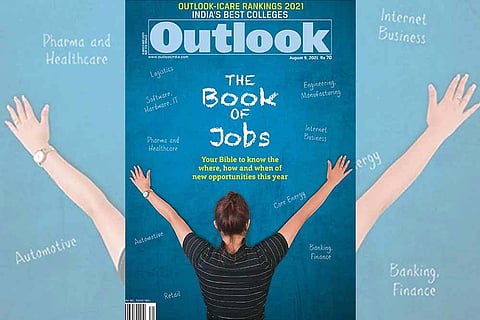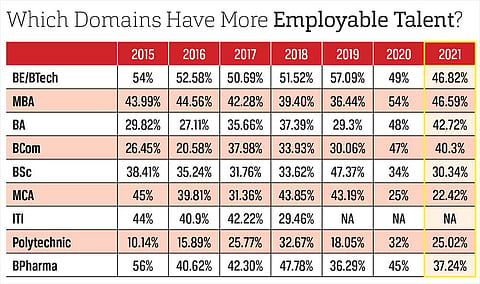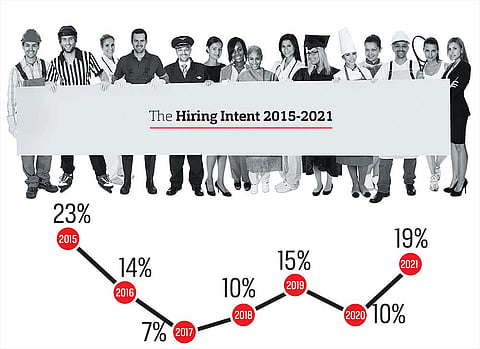It’s an inconceivable thought—99 per cent job placement in a B-School in a pandemic-ravaged 2021. But it happened for real. Of these, 40 per cent were bagged by women, and almost a quarter of them were hired for leadership roles. The online hiring at the Indian School of Business (ISB) took place in February this year, or just before the second wave of Covid. But, Uday Virmani, senior director, career advancement service, ISB, says “the big names, including McKinsey, Bain, Deloitte and Accenture, came with lucrative offers”.
Job Alert! Hirings Are Back As India Inc Beats Pandemic Blues
After a severe battering due to the Covid pandemic, the job market is opening up and companies are looking to hire again. A look at the most prospective sectors.
A third of the jobs that the ISB students accepted were in consulting, which is a coveted field for any management graduate. More importantly, each company that participated in the placements took on an average of six students, and each candidate got an average of 1.8 offers, i.e. most had more than one in their pockets and chose between them. The average annual cost-to-company emoluments rose to more than Rs 2.8 million in 2021, almost 10 per cent higher than the previous year.
What happened with ISB is exceptional, but not unique. As new data comes in, it is evident that Indian employers are excited and enthusiastic about the immediate future of jobs. If a third Covid wave spares us, or if it comes in a less deadly form, the employment mart may boom for aspirants at every level—from entry stages to highest ones. India Inc. may bounce back, and the situation may soon be back to the pre-pandemic period. However, the contours of jobs will never be the same.

Mercer|Mettl, the global leader in talent assessment, stated in its State of Talent Acquisition Report, 2021, that after the mayhem in 2020, which led to huge unemployment, data on the hiring front for this year “looks promising”. It added that HR managers across companies and several sectors are optimistic in their outlook. Mercer’s latest survey concluded that 60 per cent of the companies wanted to hire people for new positions. This is as good as it gets, although the viral crisis continues.
Yet another recent report, OLX People Employer Sentiment Report, 2021, gave a rosy picture. According to it, 70 per cent of the surveyed employers confirmed that they had resumed hiring. While only a small percentage of them—16 per cent—filled up 100 per cent of its workers’ capacity, a sizeable 54 per cent of the firms hired up to 50 per cent of their requirement. Most of the HR managers did not have trouble scouting for the right talent, possibly because there is more of it available in the market today.
“With employers optimistic about the recovery of the Indian economy, buoyed by the mass-scale vaccination and a large number of businesses getting back on their feet, the positive hiring sentiment for blue-collar workers indicates a steady and longer-term shift,” says a confident Tarun Sinha, CEO, OLX People. In a sudden flourish, social media sites like LinkedIn are flooded with job ads. “For months, I found nothing. Now, there are a few new ones posted every day,” says one of the aspirant-applicants.

Anecdotal evidence shows that a large portion of those who lose their jobs or witness salary slashes start their own ventures or become consultants to survive. “Gone are the days when doctors and engineers were in demand. Today, the skilled youth has ample opportunities to join the gig ecosystem in areas such as social media, sales, content creation, customer-support, coding, reselling and others,” explains Prerna Kalra, co-founder and CEO, Daalchini Technologies.

But the fact remains that there is segregation or differences across sectors. “In industries that are doing well now, there are huge employment demands,” contends R.P. Yadav, CMD, Genius Consultants. The ones that are struggling in the aftermath of the coronavirus outbreaks and series of lockdowns are still cagey about recruiting more people. In effect, it implies that some areas will boom in the near future, and the laggards will take some time, maybe a year or two, to reboot and revive.
Among the happening sectors, the obvious ones, according to Yadav, are healthcare, pharmaceuticals, e-commerce, retail, telecom, logistics and IT. Technology and IT continue to employ the maximum number of people. For instance, the latest report by naukri.com, Naukri JobSpeak Trends, reveals that employment in the IT-software sector surged by a 14 per cent sequential growth in May 2021, followed by a further 5 per cent in the next month. This is true of tech-related jobs in other areas too.
“IT remains the key performer in terms of hiring activity, achieving an all-time high growth of 52 per cent now, compared to pre-Covid levels in June 2019,” says Pawan Goyal, chief business officer, naukri.com, a major placement firm. Since technology is fast becoming a key driver to spur growth in various industries, there is a growing demand for skills in artificial intelligence (AI), robotics, data analytics and machine-learning (ML) in manufacturing and allied services.

“The adoption of robotics in manufacturing and warehousing will improve the nature of available jobs. Robots will eliminate the strenuous work of moving and lifting heavy materials, even as the more interesting activities that require hand-eye coordination and subjectivity remain with humans. The workforce will remain healthy, both physically and mentally. Also, the maintenance of robots will create highly-skilled jobs,” says Satish Shukla, co-founder and head (HR and marketing), Addverb Technologies.
Similarly, more and different kinds of employment will emerge in the healthcare sector, once the hospitals’ business becomes more stable. At present, explains Navnit Singh, CMD (India), Korn Ferry, a global consulting firm, “elective surgeries” take a backseat, as the medical infrastructure and fraternity tackles the Covid crisis. Over the next few years, he adds, there will be opportunities for trained individuals in hospitals as well as allied areas like medical devices.
E-commerce, which has been on fire for the past year, will continue to be a preferred choice for employees. This year, the segment created eight or nine new Indian Unicorns, a word popularised by venture capitalist Aileen Lee to describe a privately-held start-up with a value of more than a billion dollars. In the recent past, e-commerce and digital payment players such as Zomato, Swiggy and PayTM have either come out with their IPOs, or announced their intentions to do so, and at huge valuations.

Job-seekers need to be aware that the optimistic rumblings in these areas may not continue. The growth peaks and spurts can be short-lived, as the economy slowly, but surely, trudges back to its old ways. Rakesh Jhunjhunwala, one of the richest investors, questioned Zomato’s valuation. In an interview, he said, “I think people have been far too optimistic about how fast these companies can produce cash flows.” There may be a bit of irrational exuberance around them.
Jhunjhunwala added that he won’t buy Zomato shares at the prevailing price. “I don’t have to go to every party in town because the hangover comes the next day,” he quipped. There is a likelihood that sectors like e-commerce and IT may enter a growth-plateau stage, with flattened profitability, over the next two-three years. Thus, it may be better for people to think more in terms of prospects emerging over the next two-five years. Think about the jobs of the future, not just the present.

In this context, tourism, hospitality, transportation (airline and railways) and entertainment are areas to watch out for. At present, they are in doldrums, and may take one-two years to even find their feet. But, when they recover, they will fly away on new growth paths. That can happen with infrastructure, too, as the real benefits of government stimulus packages begin to show results on the ground. Hence, it may be worthwhile to go beyond IT and technology, and keep an eye on these sectors.
Apart from sector-related trends, the actors in the labour market need to understand the intricacies of two other developments. The first is that more jobs are being created in Tier-2 cities (average growth: 23 per cent), compared to the metros (15 per cent). In the short run, the base effect will work in favour of the latter, but this will overturn by 2025. So, if you are ambitious, prepared to take calculated risks and wish to take giant leaps in the future, be prepared to venture into smaller cities.

Second, as in the case of ISB, a large proportion of the new hires are women. The 2021 Wheebox’s India Skills Report, in partnership with CII, AICTE, UNDP, LinkedIn, state governments, and others, found that women comprised 36 per cent of this year’s employment by India Inc. This is an improvement of over 30 per cent from 2015. One isn’t sure if this is related to Covid, but it is good news for those concerned with vanishing women labour and their declining participation in the job market. Over the years, the number of qualified women exceeded men—46.8 per cent and 45.91 per cent, respectively, in 2021, as per the Wheebox report. Corporate recruiters felt that a higher percentage of women are more employable, compared to men. However, the Wheebox survey, which assessed 65,000 candidates, who appeared for WNET, and spoke to 150-plus companies across 15 sectors, found that less than half of Indian youth are now considered a “highly employable” resource.
What is more deplorable is that this year’s percentage of employable young workers declined from the previous years. This state of affairs is damning in the Covid era, and can become worse in the post-pandemic period. The reason: in the ‘new normal’ period, employees will need several additional skills to cope up with the new workplaces and work culture. If things don’t change, it is likely the corporate sector will ignore a higher percentage of youngsters.
Korn Ferry’s Singh predicts a “serious talent crunch at the bottom of the pyramid” in the next two-three years. He feels that India Inc. will not have “enough trained, skilled, educated and employable people”. Such thinking seems counterintuitive in this time when almost anyone, and everyone, is either looking for a job, or changing the current one, or new ways to increase monthly income. But the new post-Covid truth may turn out to be different for both employers and employees.

Another counterintuitive trend is that as the work-from-home culture and outsourcing gathers pace, highly-skilled people will become comfortable with being on their own and working for multiple employers. A similar mindset will grip management, which will become secure with part-time workers. Although this is unfathomable today, tomorrow may witness deliberate and decisive choice by employees to opt for the freelance route. Companies, contends Singh, will grapple with both high attrition and talent shortage of right-skilled individuals. Hence, curricula will need to change to prepare people for the new realities, and India Inc. will have to constantly re-skill and retrain their existing workers to perform multiple and varied roles, some of which include those that do not exist. For instance, there is a greater appreciation for those who possess technology knowledge and understand people management. “In the past, wireless was the in-thing. There was demand for communication engineers, but now the same holds true for AI and ML,” says Sanjit Krishnan Kaul, associate professor (ECE), IIIT-Delhi.

Even students understand these gaps. “The issue is that students desperately want add-on courses in AI and ML. We have adapted and made the curriculum flexible to help them learn about such applications. Unlike two years ago, we offer additional courses to every student, including those who opt for B-Tech and M-Tech,” admits Kaul. AI has applications in areas such as environment, wildlife and smart city planning. Google and Microsoft seek skills to analyse and understand the vast amounts of data they collect. Indian industry, too, is gearing itself to bridge the knowledge and learning crevices and cracks. Ruchee Anand, director (talent and learning solutions), Linkedin, India, pointed out in the Future of Talent (2021) report that to keep pace with rapidly digitising business needs, companies are focusing on upgrading the capabilities of their workforces. Thus, 95 per cent of Indian companies have dedicated learning and development (L&D) programmes to help employees learn new skills and prepare for the future.

The report adds, “India will see more companies merge roles, up-skill their employees and hire internally to maximise business growth without expanding operational costs. Data-led hiring practices will also play a critical role in helping companies engage with their employees, attract the right talent and hire more effectively in 2021.” Sulbha Rai, chief people officer, RenewBuy, explains that “technology will play an instrumental role in hiring across sectors”, and her company hopes to use newer digital channels to reach out to the “right talent”.

Given these perceived corporate needs, new hires and existing workers need to be, in the words of Sushant Dwivedy, MD (India and the Philippines), SHL, “agile and reliable”, as well as “self-learners” with “strong work ethics and the ability to adapt”. Soft skills, which are indicative of success in remote-working, are an important part of the recruitment criteria,” adds Dwivedy, whose insights are based on survey responses from a large number of companies. This will ensure competition between both employers and employees, the former to find the right people and the latter to land preferred jobs. Such a tussle for jobs will accelerate as there is a drastic management shift towards equal employment opportunities. “Practices such as diversity, equity and inclusion (DEI) are altering hiring processes. Such outlook is likely to nurture a feeling of belongingness and create a robust talent pipeline, which is critical for organisational growth,” explained Siddhartha Gupta, CEO, Mercer|Mettl, at a press conference.

Such trends—perception among firms about the shortage of talent, feeling among aspirants and existing workers that they don’t have the additional and multiple skills, and equal opportunities—will negatively impact future employment. However, as the economy revs up—some sectors expand now and the others later—the positive effect can translate into new jobs for those who are in the market. Yet, the two-way opposing movements may divide and fracture society between the hired and jobless.
***
First Off The Mark
Hasmukh Rawal, co-founder and MD of the Pune-based Mylab, recalls a team meeting in early 2020, when Covid-19 was turning into a pandemic. The company wanted to be the first to come out with a local PCR test and have a few thousand kits in the inventory. “This was the plan...let’s make 8,000-10,000 of them. We never thought India would need millions a day.” From there on, the crisis was a jumpstart: Mylab came out with a string of firsts, topping it with a self-test kit in June this year. The CoviSelf test is one of the rare occasions that an Indian firm beat the MNCs, claims Rawal. Three million units were shipped at the launch, and the aim is to reach 95 per cent of the pincodes across the country.
But how did Mylab do it? “It’s like the Olympics, where we see only five minutes of performance. But before that our team (the players) worked for many years on several products. I think we had the right team and right pieces of the puzzle when the pandemic hit,” explains Rawal. Mylab began as an R&D outfit in 2012, and acquired a corporate image in 2016 to monetise itself. In 2018-19, it launched the Individual Donor-Nucleic Acid Test for screening donor blood samples prior to transfusions to reduce the risk of infections such as HIV. “These tests are mandatory, but we cannot afford it. So, we felt that an economical solution could save many lives,” says Rawal. “We are a social-impact-based company and we focus on high-end diagnostic tests at affordable costs.”
Last year, Mylab increased its R&D strength to work on multiple product lines in the areas of cancer and infectious diseases. “It’s a continuous innovation process. Whether the products are accepted or not is not the issue. But not doing it will be criminal for us. A solution that works in a country like ours can work everywhere, not the other way around,” he adds.
(This appeared in the print edition as "We Are Hiring")
—Ajay Sukumaran in Bangalore